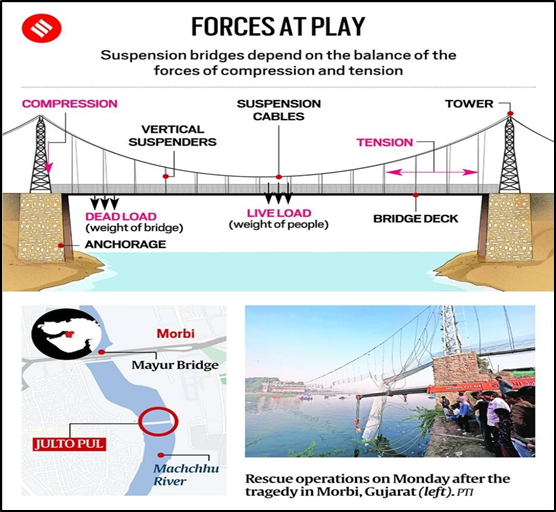In News:
- The bridge that collapsed recently in Gujarat’s Morbi killing at least 134 people, was a suspension bridge.
What’s in today’s article:
Suspension bridges
- Suspension bridge is a type in which the deck is hung below suspension cables on vertical suspenders.
- The basic structural components of a suspension bridge system include stiffening girders, two or more main suspension cables, and towers and anchorages for cables at either end of the bridge.
- The main cables are suspended between the towers and are connected to the anchorage or the bridge itself.
- The vertical suspenders carry the weight of the deck and the commuter load on it.

Working
- The design ensures that the load on the suspension cables is transferred to the towers at the two ends, which transfer them further by vertical compression to the ground by way of the anchorage cables.
- All of this balancing has to happen within the permissible weight restrictions for the bridge, given that the deck is hanging in air, supported by the two sets of cables.
Why suspension bridges are preferred?
- The reason for the enduring design of the suspension bridge is that the supporting cables running horizontally between the two far-flung anchorages.
- This provides the counterweight and effectively pass on the entire tensional force to the anchorages.
- As a result, suspension bridges can easily cross distances of well over 2,000 metres, beyond the scope of other bridge designs.
What could have happened during the Morbi bridge collapse?
- The most important load bearing members are the main suspension cables.
- The entire cross-section of the main cable is the mainstay of carrying the load and ensuring that buckling does not happen.
- But this is subject to two preconditions: there must be no overloading, and no excessive swaying.
- Even as an investigation into the accident is pending, the visuals and purported footage prior to the incident seem to suggest that:
- The 19th century bridge, which had been reopened recently after repairs, reportedly had over 400 people on it when it collapsed.
- Also, the video footage from before the incident seems to suggest the bridge was swaying, possibly because of the large crowd on it.










